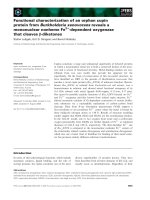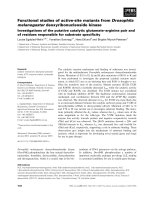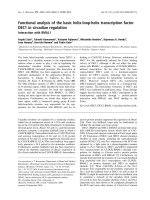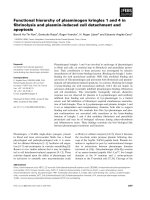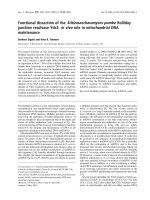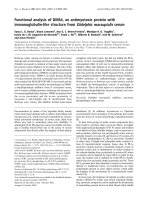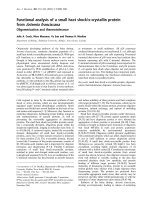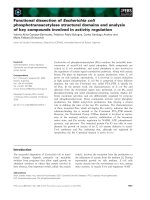Báo cáo sinh học: "Functional genomics of cell morphology using RNA interference: pick your style, broad or deep" doc
Bạn đang xem bản rút gọn của tài liệu. Xem và tải ngay bản đầy đủ của tài liệu tại đây (67.52 KB, 5 trang )
Minireview
Functional genomics of cell morphology using RNA interference:
pick your style, broad or deep
Thomas D Pollard
Address: Departments of Molecular Cellular and Developmental Biology and Cell Biology, Yale University, New Haven, CT 06520, USA.
Email:
Given complete genome sequences from a growing number
of organisms, investigators are confronted with how, most
efficiently, to complete the inventory of proteins that partici-
pate in complex cellular processes, such as cytokinesis, cellu-
lar motility or the establishment of asymmetric cell shapes.
Such an inventory is the essential first step in beginning to
think mechanistically about how any such system of interde-
pendent parts functions as a whole. In the pre-genomic era,
classical forward genetics (screening of mutants), biochemi-
cal isolation with reconstitution, and pharmacology pro-
vided laborious but definitive methods to connect genes
with molecular functions, working on one protein at a time.
Now, strategies can aim for broad or even complete cover-
age. Experiments with budding yeast led the way with four
sorts of experiments: first, a complete set of deletion muta-
tions, which showed that only 19% of the 6,200 genes are
required for viability in the laboratory [1]; second, crosses
between viable deletion strains, revealing synthetic interac-
tions [2]; third, large-scale two-hybrid assays mapping out
networks of protein-protein interactions [3]; and fourth,
comprehensive tagging with green fluorescent protein (GFP)
to visualize subcellular localization [4]. Such experiments
are complicated in higher eukaryotes, where homologous
recombination is more difficult to achieve.
Fortunately, RNA interference (RNAi) came to the rescue,
providing a simple method for depleting specific mRNAs,
and making it possible to assay for the effects of loss of
protein function on a grand scale. Pioneering experiments
with Caenorhabditis elegans examined the effects of systemat-
ically deleting mRNAs for most of the 2,769 genes on chro-
mosome I [5] and 2,300 genes on chromosome III [6]. Both
of these studies assayed for gross developmental and func-
tional defects - supplemented in the chromosome III study
with high-resolution time-lapse movies of the first two
embryonic cell divisions. Both studies yielded phenotypes
for about 13% of the genes screened, including most, but
not all, of the genes on these chromosomes that were
already known to give developmental phenotypes.
The Drosophila community has followed suit, with several
new studies using RNAi to deplete mRNAs and proteins
from tissue-culture cells [7-10]. The method is simple and
efficient. Where antibodies were available for testing, the
Abstract
Several new studies have used RNA interference to screen for protein functions affecting cell
shape, mitosis and cytokinesis of Drosophila cells in culture. One broad survey of nearly 1,000
proteins and three studies focused on cytoskeletal and motor proteins have identified key
proteins essential for these processes in animal cells.
BioMed Central
Journal
of Biology
Journal of Biology 2003, 2:25
Published: 1 October 2003
Journal of Biology 2003, 2:25
The electronic version of this article is the complete one and can be
found online at />© 2003 BioMed Central Ltd
levels of target proteins were found to be reduced by more
than 90%, and sometimes more than 99%. These studies
represent a range of styles, from a highly focused examina-
tion of the role of 26 microtubule motors in mitosis [7] to a
much more ambitious screen of nearly 1,000 mRNAs for
possible effects on cellular morphology and division [8].
Where they overlap in the genes studied, these studies gen-
erally agree on which depletions produce defects in cytoki-
nesis or in the actin cytoskeleton in the lamellae of spread
cells (Table 1).
When initiating such a screen, a decision must be made
regarding breadth or depth, because for practical reasons the
assays can be more detailed in a small screen than in a very
broad one. For example, the relatively small size of the
screen of microtubule motors enabled Goshima and Vale [7]
to use time-lapse microscopy of cells expressing GFP-tubulin
to identify subtle phenotypes. This kinetic information
allowed them to detect, for example, that depletion of
dynein caused the cells to delay at the metaphase-to-
anaphase transition, before completing an otherwise normal
mitosis. The other studies relied on fluorescence microscopy
of fixed cells to reveal effects of protein depletion on cellular
shape, the actin cytoskeleton, microtubules or the process of
cytokinesis. Somma et al. [9] focused on eight proteins sus-
pected to participate in cytokinesis. Kiger et al. [8] hand-
picked a selection of 994 Drosophila genes, many known to
be functional from mutagenesis studies and others suspected
to be functional from work in other systems; their targets
included not only cytoskeletal and motor proteins, but also a
large number of cell-cycle, signal-transduction and receptor
proteins. Rogers et al. [10] screened 90 targets known to be
components of the actin cytoskeleton for defects in cyto-
kinesis and/or extension of leading lamellae. In addition,
Kiger et al. [8] examined two Drosophila cell lines with dis-
tinct morphologies: large, flat S2R
+
cells and small, round
Kc
167
cells. Some RNA depletions produced phenotypes in
both lines, but others produced different phenotypes in the
two lines or a phenotype in only one of the two lines. The
other groups [7,9,10] tested S2 cell lines; and Rogers et al.
[10] plated their S2 cells on concanavalin A, to promote
spreading on the microscope slide.
These studies all agree on target RNAs that give cytokinesis
phenotypes: those encoding anillin, citron kinase, cofilin,
Diaphanous, myosin-II heavy chain, myosin-II regulatory
light chain, Pavarotti/kinesin, Pebble Rho GTPase exchange
factor (GEF) and Rho1 GTPase. Of the three groups that
performed the studies, only Rogers et al. [10] found a
cytokinesis phenotype with RNAi targeting profilin and
cyclase-associated protein. The Rogers et al. [10] and Kiger et
al. [8] screens also agree on the RNA depletions that cause
defects in the actin-based lamella and alter cellular shape:
Abl tyrosine kinase, Arp2/3 complex, capping protein,
Cdc42, cofilin, cofilin phosphatase, cyclase-associated
protein, profilin and Scar. The screens did not agree on
whether lamellar or cell-shape defects were found with the
depletion of the following 15 RNAs: Aip1, formin, anillin,
Rho1 GTPase, Aurora kinase, cortactin, Nck, Rac2, Abelson-
interacting protein, Enabled kinase, Rho kinase, PAK, Rho
GEF (vav), phosphatidylinositol trisphosphate (PIP
3
) phos-
phatase (Pten), and myosin essential light chain (unnamed
open reading frame CG15780). In four of these cases, one
of the labs did not test the RNA, but with depletion of the
remaining 11 RNAs one lab found a lamellar defect whereas
the other lab did not (Table 1).
Given the functional bias in the selection of the target RNAs
for all of these Drosophila RNAi screens, it is striking how
many individual proteins can be depleted with little or no
effect on tissue-culture cells. The microscopic assays by
Kiger et al. [8] revealed phenotypes such as changes in cell
shape or the accumulation of multinucleated cells upon
depletion of only 160 of the RNA targets (one third of
which correspond to a gene lacking a previously character-
ized mutant allele). In the Rogers et al. screen [10] depletion
of 66 of 90 known cytoskeletal targets had no effects on
lamellar morphology or cytokinesis; these 66 include a
number of overlaps with negative results from the Kiger et
al. screen: Ciboulot, filamin, gelsolin, several myosins,
tropomodulin, tropomyosin and Wiskott-Aldrich syndrome
protein (WASP).
What is the explanation for the RNA depletions with no
phenotype in these assays? Are these true negatives or false
negatives? A trivial explanation is a failure of depletion, but
the efficiency of depletion is impressive in the examples
tested. Somma et al. [9], Rogers et al. [10] and Goshima and
Vale [7] confirmed that S2 cells express most of the RNAs
that they tested, ruling out another trivial explanation for a
negative result, namely absence of the target. Kiger et al. [8]
included many mRNAs encoding proteins with specialized
functions in differentiated tissues such as muscle, nerve or
germ cells, so some of their negative results are expected for
S2 cells as they lack these functions.
Geneticists might tell us not to worry about the false nega-
tives, since they are inevitable in any screen. But if one
wants to reach the goal stated at the outset - a complete
inventory of the proteins that participate in a complex cellu-
lar process - one cannot ignore the negatives. The highly
focused test of microtubule motors in mitosis [7] provides
some clues about the negative results. Goshima and Vale [7]
targeted all 25 kinesins and the single dynein in the
Drosophila genome. Their assay on live cells detected subtle
phenotypes, such as the delay in metaphase caused by
25.2 Journal of Biology 2003, Volume 2, Issue 4, Article 25 Pollard />Journal of Biology 2003, 2:25
Journal of Biology 2003, Volume 2, Issue 4, Article 25 Pollard 25.3
Journal of Biology 2003, 2:25
Table 1
Screens for lamellar and cytokinesis phenotypes in cultured Drosophila cells
Phenotype: Cytokinesis Lamellar Actin/shape
Cell type: S2 S2 S2R, Kc
167
S2 cells S2R, Kc
167
Study: Somma et al. [9] Rogers et al. [10]; Kiger et al. [8] Rogers et al. [10] Kiger et al. [8]
Goshima and Vale [7]
Protein (gene)*
Myosin-II (zipper)NT+ -
†
†
Myosin RLC (spaghetti squash)+ NT + NT -
Profilin (chickadee)-+ -
†
++
†
CAP (act up/capulet) NT + - + +
Cofilin (twinstar)+++++
Actin interacting protein 1; Aip1 NT + NT + NT
Formin (diaphanous)NT+ + - +
Anillin (scraps)+++-+
Kinesin (pavarotti)++ + - -
Rho1 GTPase + + + + -
Rho GEF (pebble)+NT+ NT-
RacGAP; RacGAP50C + + - - -
Syntaxin1A + NT NT NT NT
Dynamin (shibire)NTNT+NT-
Citron kinase NT + + - -
Aurora kinase NT NT + NT +
Arp2/3 complex NT - - + +
Scar NT - - + +
Cortactin NT - - - +
Nck (dock)NT +-
Cdc42 GTPase NT - - + +
Rac1/2 GTPase NT - - - + (Rac2 only)
Capping protein NT - - + +
Abl kinase NT - - + +
Abelson-interacting protein (abi)NT - - + -
Enabled kinase NT - - - +
Rho kinase NT NT - NT +
PAK NT - (PAK1) - - + (PAK3)
Cofilin phosphatase (slingshot) NT - - + +
Rho GEF (vav)NT +
PIP
3
phosphatase (pten)NT NT - NT +
Other myosins NT - - - +
(uncharac-
terized ORF,
CG15780)
Polo kinase NT NT +
‡
NT +
‡
LIM kinase NT - - - -
depletion of the dynein heavy chain, which might have
been reported as a false negative in a study with fixed cells.
Depletion of any of eight single kinesins compromised for-
mation of a bipolar spindle or the alignment of chromo-
somes on the metaphase plate, but depletion of multiple
kinesins with related functions was required for severe mis-
alignment of metaphase chromosomes. Loss of one kinesin
(Pavarotti) compromised cytokinesis owing to disruption of
the central spindle, but depletion of two other kinesins had
no effect on cytokinesis in spite of the ability of mutations
in the respective genes to have an effect. One-off depletion
of 17 other kinesins had no detectable effect on cell divi-
sion, and no single kinesin depletion slowed anaphase
chromosome movements. Only 3 of the 26 depletions
caused defects so substantial that the cells failed to find an
alternative pathway to complete mitosis.
Thus, redundant function, alternative pathways and antago-
nistic actions are the rule rather than the exception in cell
division and probably in many other vital processes. The
frequent lack of phenotypes upon depletion of single pro-
teins simply reflects the complexity of redundant molecular
machines with multiple safeguards to protect function.
Most negatives in the RNAi screens are therefore likely to be
real negatives rather than false negatives, but this does not
indicate lack of function.
The occurrence of proteins lacking RNAi phenotypes opens
the door to combinatorial RNAi screens for synthetic interac-
tions and the construction of protein interaction networks (as
in yeast [3]). Double RNAi depletions have already revealed
synthetic interactions between some kinesins [7] and
between the signaling molecules Nck and Rac [10]. Other
modifier screens are feasible; for example, Kiger et al. [8]
show RNAi suppressor interactions between the Pten phos-
phatase and 20 kinases. The targets that do have positive
RNAi phenotypes need to be followed up with targeted gene
disruption and/or gene replacement, to investigate mecha-
nisms. This has been the Achilles’ heel for Drosophila, but
fortunately, gene targeting is becoming more efficient [11].
Both focused and broad approaches to RNAi have strengths,
so that the way that one screens is largely a matter of taste. As
someone interested in the details of molecular mechanisms,
I am inclined toward slow, deliberate screens with high-
resolution assays in an effort to maximize the information
extracted on the first try. Such ‘second generation’ screens
should include verification of the expression of each target in
controls and its depletion in test cells. On the other hand,
one cannot deny the importance of broad depletion screens
designed to give a comprehensive account of genes that con-
tribute to cellular function, such as the shape and morphol-
ogy assay of Kiger et al. [8]. Fortunately, the groups of
Norbert Perrimon at Harvard Medical School and Renato
Paro in Heidelberg, Germany have set up the ‘Drosophila
RNAi Screening Center’ (DRSC) [12], with a library of RNAi
reagents for all of the known open reading frames in the
Drosophila genome and facilities for high-throughout screens.
Support from the National Institute of General Medical Sci-
ences makes this resource available to other investigators,
and the DRSC is eager to collaborate with experts with
sophisticated assays for various cellular activities.
25.4 Journal of Biology 2003, Volume 2, Issue 4, Article 25 Pollard />Journal of Biology 2003, 2:25
Table 1 (continued)
Phenotype: Cytokinesis Lamellar Actin/shape
Cell type: S2 S2 S2R, Kc
167
S2 cells S2R, Kc
167
Study: Somma et al. [9] Rogers et al. [10]; Kiger et al. [8] Rogers et al. [10] Kiger et al. [8]
Goshima and Vale [7]
Protein (gene)*
Ciboulot NT - - - -
Coronin NT - NT - NT
Filamin NT - - (jitterbug)- - (jitterbug)
Gelsolin NT - - - -
Tropomodulin (sanpodo)NT - - - -
Tropomyosin NT - NT - NT
Septin (peanut) - NT NT NT NT
WASP NT - - - -
+ indicates that a cytokinesis or lamellar phenotype was observed; -, no phenotype was observed; NT, not tested. *Protein names (sometimes more
than one alternative) are given in roman type and gene names in italics.
†
In unpublished experiments, accumulation of actin and disruption of the cell
monolayer was found with profilin RNAi and a cytokinesis phenotype was seen with zipper RNAi (A. Kiger, personal communication).
‡
Mitotic
phenotypes were observed.
Having struggled to compare the recent RNAi studies in
Drosophila [7-10], I feel compelled to finish with an observa-
tion about gene names. The clever and amusing names that
geneticists have assigned to mutations and/or genes are gen-
uinely hampering communication. Even for someone famil-
iar with a particular field, matching dozens of meaningless
gene names with generic protein names has become impos-
sible. FlyBase [13] is an indispensable resource that allowed
me to sort out most of the nomenclature, but a trip to
FlyBase or PubMed [14] should not be required to match
pavarotti with a kinesin, sanpodo with tropomodulin or zipper
with cytoplasmic myosin-II heavy chain. The three letter
and number nomenclature used by the yeast community to
name yeast genes is just as opaque. Although it is strenu-
ously resisted (“our history will be lost”), it is past time for
gene names to be converted as soon as practical to common
usage in all of the genetic model organisms. Nomenclature
also needs to be consolidated across the phylogenetic tree,
as has been done for myosins [15] but not yet for kinesins,
where some family members have five or more names. The
insights promised by new technologies such as RNAi may
be wasted if jargon impedes communication with many
interested readers.
Acknowledgements
I thank Amy Kiger for suggestions on the text and help with gene names.
References
1. Giaever G, Chu AM, Ni L, Connelly C, Riles L, Veronneau S, Dow
S, Lucau-Danila A, Anderson K, Andre B, et al.: Functional pro-
filing of the Saccharomyces cerevisiae genome. Nature 2002,
418:387-391.
2. Tong AH, Evangelista M, Parsons AB, Xu H, Bader GD, Page N,
Robinson M, Raghibizadeh S, Hogue CW, Bussey H, et al.: Sys-
tematic genetic analysis with ordered arrays of yeast dele-
tion mutants. Science 2001, 294:2364-2368.
3. Tong AH, Drees B, Nardelli G, Bader GD, Brannetti B, Castagnoli
L, Evangelista M, Ferracuti S, Nelson B, Paoluzi S, et al.: A com-
bined experimental and computational strategy to define
protein interaction networks for peptide recognition
modules. Science 2002, 295:321-324.
4. Kumar A, Agarwal S, Heyman JA, Matson S, Heidtman M, Piccirillo
S, Umansky L, Drawid A, Jansen R, Liu Y, et al.: Subcellular local-
ization of the yeast proteome. Genes Dev 2002, 16:707-719.
5. Fraser AG, Kamath RS, Zipperlen P, Martinez-Campos M,
Sohrmann M, Ahringer J: Functional genomic analysis of C.
elegans chromosome I by systematic RNA interference.
Nature 2000, 408:325-330.
6. Gonczy P, Echeverri C, Oegema K, Coulson A, Jones SJ, Copley
RR, Duperon J, Oegema J, Brehm M, Cassin E, et al.: Functional
genomic analysis of cell division in C. elegans using RNAi
of genes on chromosome III. Nature 2000, 408:331-336.
7. Goshima G, Vale, RD: The roles of microtubule-based motor
proteins in mitosis: comprehensive RNAi analysis in the
Drosophila S2 cell line. J Cell Biol 2003, 162:1003-1016.
8. Kiger AA, Baum B, Jones S, Jones MR, Coulson A, Echeverri C,
Perrimon N: A functional genomic analysis of cell morphol-
ogy using RNA-interference. J Biol 2003, 2:27.
9. Somma MP, Fasulo B, Cenci G, Cundari E, Gatti M: Molecular
dissection of cytokinesis by RNA interference in
Drosophila cultured cells. Mol Biol Cell 2002, 13:2448-2460.
10. Rogers SL, Wiedemann U, Stuurman N, Vale RD: Molecular
requirements for actin-based lamella formation in
Drosophila S2 cells. J Cell Biol 2003, 162:1079-1088.
11. Gong WJ, Gorlic KG: Ends-out, or replacement, gene tar-
geting in Drosophila. Proc Nat Acad Sci USA 2003, 100:2556-
2561.
12. Drosophila RNAi Screening Center []
13. FlyBase []
14. PubMed [ />15. Berg JS, Powell BC, Cheney RE: A millennial myosin census.
Mol Biol Cell 2001, 12:780-794.
Journal of Biology 2003, Volume 2, Issue 4, Article 25 Pollard 25.5
Journal of Biology 2003, 2:25

